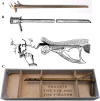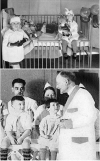Chevalier Jackson: father of endoscopic surgery, and champion of women in medicine, social justice, and public health
- PMID: 37439820
- PMCID: PMC10462558
- DOI: 10.1007/s00464-023-10256-x
Chevalier Jackson: father of endoscopic surgery, and champion of women in medicine, social justice, and public health
Abstract
Backgrounds: Chevalier Jackson (1865-1958) was a pioneering force in the medical world, whose extraordinary contributions to surgery and public health have left an indelible impact. He developed the endoscope and perfected the bronchoscope, and his mastery of these tools enabled him to transform the prognosis of foreign body aspiration from 98% mortality to 98% survival. He was also a passionate advocate of public health chairing the national committee on lye legislation, which culminated in the Caustic Poison Act, responsible for poison and antidote labels. Yet Jackson's accomplishments were not limited to these. The aim of this manuscript was to shed light on Chevalier Jackson's lesser-known contributions to surgical science and culture, and to celebrate and honor the life of this remarkable surgeon.
Methods: Digital and physical historical records from the National Library of Medicine, Smithsonian Institution, Heinz History Center in Pittsburgh PA, and Sunrise Mill Museum, Montgomery County PA were reviewed for Chevalier Jackson's scientific, cultural, and social contributions to the field of surgery.
Results: Among his lesser-known contributions, Chevalier Jackson was the first to describe erosive esophagitis. He developed the first standardized tracheotomy procedure, still in use today. He was ahead of his time in many ways, pioneering a multidisciplinary approach to medicine, advocating for patient-centered care, and advancing the inclusion of women in the medical profession.
Conclusion: Chevalier Jackson's legacy extends far beyond the tools and techniques he invented. He was a champion of social justice, a protector of patients, and an inspiration to medical professionals across the globe.
Keywords: Bronchoscopy; Chevalier Jackson; Endoscopy; Foreign body; History of medicine; Women in medicine.
© 2023. The Author(s).
Conflict of interest statement
Drs. Sven E. Eriksson, Blair A. Jobe and Shahin Ayazi have no conflicts of interest or financial disclosures.
Figures










References
-
- American College of Surgeons Yearbook . First convocation held at Chicago November 13, 1913. Washington: American College of Surgeons; 1913.
-
- Jackson C. The life of Chevalier Jackson: an autobiography. New York: The MacMillan Company; 1939.
-
- Jackson, Chevalier. Chevalier Jackson papers. 1890–1964. Located in: modern manuscripts collection, history of medicine division, National Library of Medicine, Bethesda, p. 292.
-
- Tells of Radium for Lung Cancer: Dr. Chevalier Jackson explains use of seeds before the bronchoscopic society. New York Times. 1930, May 28th.
-
- Marsh BR. Historic development of bronchoesophagology. Otolaryngology—Head and Neck Surgery. 1996;114(6):689–716. - PubMed
Publication types
MeSH terms
LinkOut - more resources
Full Text Sources

